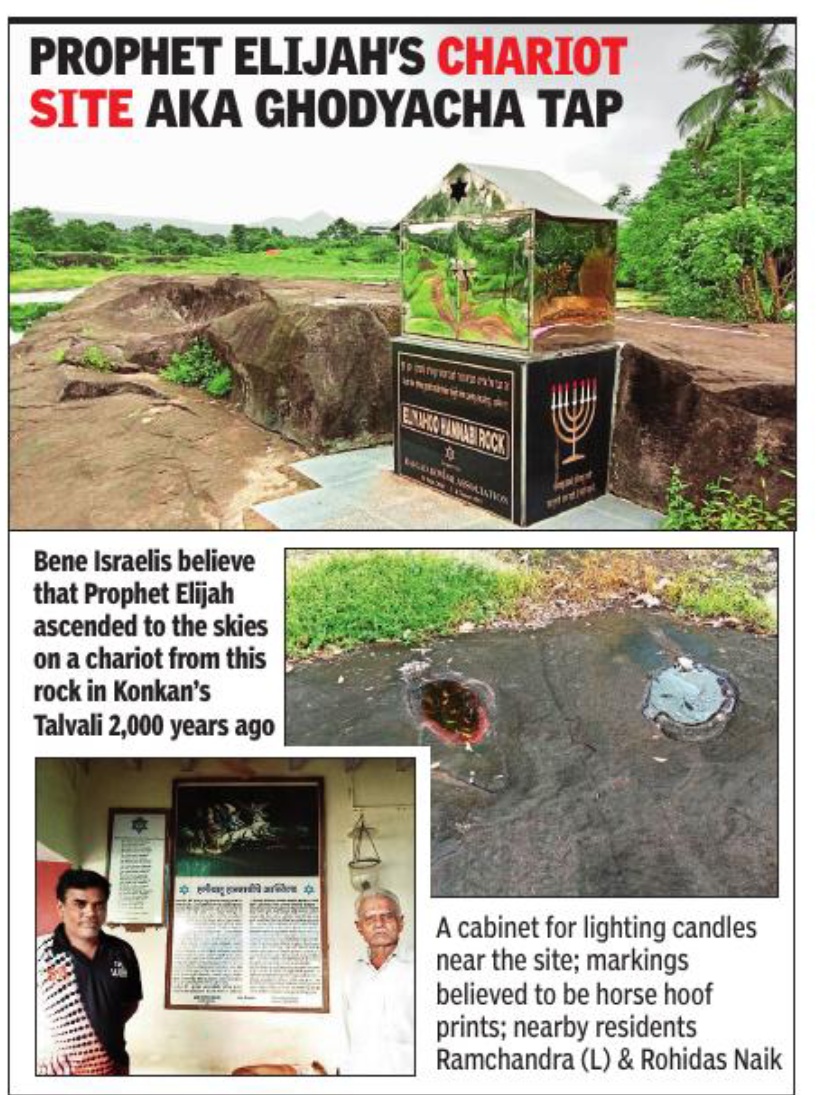Karle: Ghodyacha Tap
This is a collection of articles archived for the excellence of their content. |
Prophet Elijah’s Chariot Site?
As in 2023
Sharmila Ganesan, Sep 10, 2023: The Times of India

From: Sharmila Ganesan, Sep 10, 2023: The Times of India
Of the 12 fans that were donated to this warm household near Alibaug over a decade ago, two remain. Rains have banished the rest over time so now, in this entryway shared by Lord Ganesha and a robed prophet named Elijah, hang only two ceiling fans, expecting unexpected guests. Ever since the Naiks moved to Konkan’s tiny Karle village in the 1990s, strangers have kept arriving in search of various things — knives, plates, glasses, water, information, matchsticks, mythology. “They say shalom. We say namaste,” says Ramchandra Naik about the Jewish visitors from Alibaug, Thane, Mumbai, Pune and even Israel who come down to light candles at the flat, smooth nearby rock on which his family lights a garbattis. Known locally as ‘Ghodyacha Tap’ and internationally as Prophet Elijah’s Chariot Site, Prophet Elijah’s Rock leaps out amid the synagogues, libraries, cemeteries and schools that are part of the Jewish Route, a recently-inaugurated tourism initiative comprising 26 Jewish heritage structures across the state. “We call it Ghod Khatar,” says Ramchandra. “‘Ghod’ means horse, ‘Khatar’ means stone. ” Curiosity about the structure bearing mystical imprints of horse hoofs and chariot wheels typically peaks when a vehicle with more than two wheels takes the narrow, undulating path down from ‘Sagaon Maruti’, a well-known Lord Hanuman temple near Talvali, a village adjoining Karle. “But how come the horse footprints are so deep when it happened all those years ago?” asks our auto driver. Ramchandra’s 75-year-old father Rohidas Naik aka ‘Bhai’, isn’t tired of repeating the legend, “Tuffy, sit down,” says Bhai, lowering the head of his excitable pet stray with a stick to clear our view of the Marathi text on his entryway wall detailing the mythology of ‘Eliyahoo Hannabi’. Hebrew for Prophet Elijah, ‘Eliyahoo Hannabi’ refers to a miracle worker from 9th Century BCE who is exalted “almost to the status of a patron saint by the Bene Israels,” says Shaul Sapir, professor of historical geography at Jerusalem’s Hebrew University and ‘Bombay: Exploring the Jewish Urban Heritage’ author.
When the Bene Israelis fled the northern kingdom of Israel and arrived at Konkan coast 2000 years ago, Prophet Elijah is believed to have revived the unconscious members who had washed up on the beach. Shipwrecked at Nagaon, the community sought help from the locals who employed them as oil pressers.
“The Bene Israel legend narrates two occasions when Eliyahu Hanabi visited India and ascended to heaven. The first account recounts his stop at Talvali,” says Sapir. “It is said Prophet Elijah took off from here into the sky on a chariot of fire. The chariots’ wheels and horses’ footprints visible at this site, are imprinted on a large rock,” he adds.
Ramchandra says the rock used to be so big that it covered not only the pond to the right but also the one to the left lined by tall, picturesque cacti. Fresh rainwater has turned the two deep football-sized indents — believed to be horse hoof marks — into puddles. “That’s where the horse took off from after the chariot slipped from there,” he says, pointing us to the start of an artery-like white line at the start of which are lilies and burnt-out incense sticks placed by his family.
“We too break coconuts there as we have adopted local customs,” says Noel Chincholkar, secretary of the Raigad Jewish Association which has built a steel cabinetnear the rock for the Bene Israelis who come down to perform ‘Malida’, a thanksgiving ceremony meant to celebrate new babies, anniversaries or other ‘Simchas’ (happy events) by invoking Prophet Elijah.